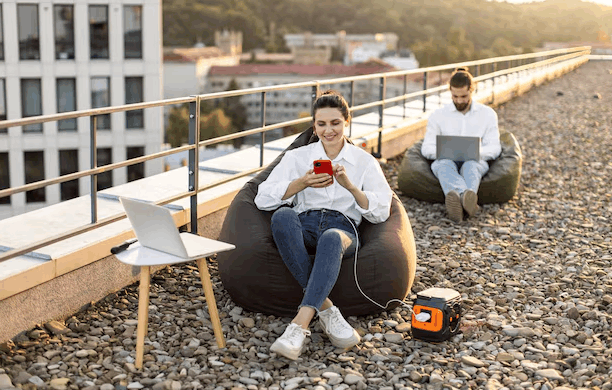
Innovative tech can blur the line between work and play. Whether it’s a rooftop garden, a nearby park bench, or a comfortable backyard patio, these spaces help people relax and focus simultaneously.
Incorporating work-ready outdoor areas into office environments and corporate campuses offers multiple benefits for employees and organizations. To create successful outdoor workspaces, however, it requires the right technology.
Stay connected with the best outdoor WiFi extenders of 2024 by reading this article.
1. Connectivity
Workplace design is rapidly evolving to embrace flexible workspaces catering to different workflows. With a mobile workforce and remote teams growing in popularity, making the transition between spaces seamless for employees is critical.
Outdoor spaces like garden patios, rooftop terraces, and indoor-outdoor connections between traditional conference rooms and informal meeting areas allow employees to decompress in a refreshing environment that enhances productivity. These connections between spaces allow for organic interactions between employees from various departments or even across companies that can lead to new ideas and innovative projects.
While it’s essential to create a comfortable space, providing employees with the right tools and technology for working outside is also essential. For instance, ensuring enough power outlets is vital to ensure everyone can stay productive while working outdoors. Additionally, strategically placing shading elements and heaters (like Bromic’s range of innovative heating solutions) helps maintain comfort and usability in all weather conditions.
In addition to enhancing collaboration and productivity, outdoor workspaces can serve as gathering places for employee events and social activities. In a high-rise office, for example, a rooftop terrace can become the hub of the community, where tenants gather for morning yoga sessions, weekend barbecues, and other events that foster connection with colleagues outside the workplace.
2. Adaptability
Adaptability is a non-negotiable workplace skill in today’s rapidly changing work environment. Leaders and professionals have had to quickly learn to navigate new remote, asynchronous work policies and technologies and manage teams across time zones and cultures. Adaptability soft skills include empathy, communication, and mindfulness, all of which are critical to successful workplaces.
In the past, workplace design trends often focused on ways to bring nature into office spaces. This approach tapped into the biophilia hypothesis, which states that we have an innate need to connect with nature. Now, many organizations are creating outdoor workspaces that provide a healthy alternative to stuffy offices and support the need for more balance between professional productivity and the comforts of home life.
Outdoor workspaces are a natural setting for collaborative, creative work. They also encourage movement and physical activity, which improves posture and promotes healthier lifestyles. This makes them a great alternative to sedentary desk jobs that can lead to neck and back pain.
To maximize their effectiveness, outdoor workspaces should be equipped with various amenities that help employees focus. Depending on the climate, this might include sunshades and canopies to block out sunlight during scorching summer months or heat lamps, ceiling fans and radiant heating to keep people comfortable in colder weather.
Learn the step-by-step process of setting up a wireless bridge here.
3. Ergonomics
A comfortable and productive workspace is essential for employees’ health, as well as their productivity. When workers suffer from pain or fatigue, their attention spans and mental insights are impacted negatively, and the effects can trickle into other areas of their lives. By investing in ergonomic improvements to the workplace, including adjustable furniture, chairs desks and computer monitors designed with ergonomics in mind, employers can prevent work-related injuries that can lead to costly Workers’ Compensation claims.
Ergonomic design also benefits employees' physical health, including reducing strain on arms and wrists from repetitive movements or a lack of support when using keyboards and mice. It encourages good posture while sitting or standing, which decreases the risk of back problems. It also helps to reduce eye strain caused by prolonged viewing of screens. Ergonomic improvements can significantly improve employee morale and satisfaction in the workplace, as they can help them feel more energized and empowered to achieve their work goals.
Another benefit of ergonomics is encouraging movement throughout the day to avoid the adverse effects of static positioning and to keep muscles limber and active. Adding elements like trellis and panel screens, plantings and fountains can define outdoor office meeting spaces and curb visual and noise distractions. Mobile weatherproof seating with stackable options makes it easy to reconfigure seating in informal team meetings, and various furniture materials can complement the outdoor setting while offering flexibility, comfort and utility.
4. Convenience
Outdoor workspaces offer respite from the everyday office environment. The presence of plants, natural daylight and fresh air can improve productivity and inspire new ideas. Additionally, the movement and physical activity involved in working outdoors encourages healthy posture, which can offset the adverse effects of sitting for extended periods.
Adding an outdoor work area to the workplace can motivate employees who want to prioritize their wellness in the office. Whether it’s a small breakout space in a cafe or a more extensive outdoor patio with comfortable seating and work surfaces, these spaces are a popular option for productive collaboration and heads-down work.
However, the design of these spaces should be carefully considered to ensure productivity. To make the most of the space, include versatile furniture that can accommodate various workflows and support group meetings and solo tasks. Lounge seating with lightweight shared surfaces, high-top tables with stools, and traditional desk chairs will allow everyone in the team to work comfortably and productively. Flexible power solutions like a portable charger and Flex Mobile Power are also an essential to any outdoor workspace.
Despite the benefits, it’s important to remember that when working outdoors, battery life may be shorter and temperatures can change rapidly. To counteract this, provide shade to reduce direct sunlight and incorporate large fans to help move the air and reduce humidity. In addition, consider ways to create a comfortable and productive workspace during winter, such as providing heaters for warmth and supplemental lighting.





Comments